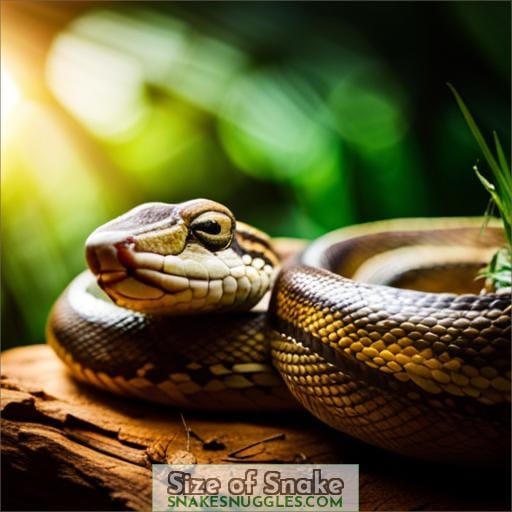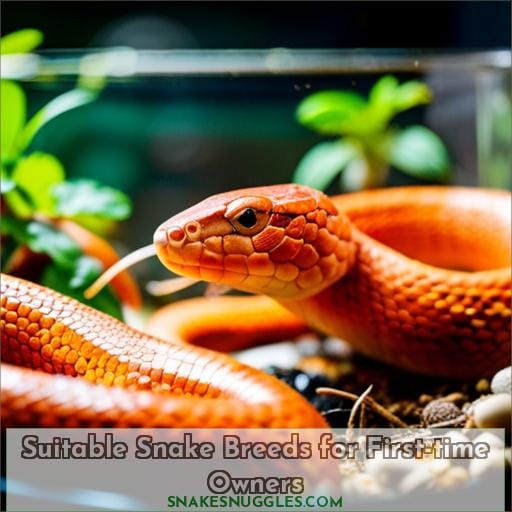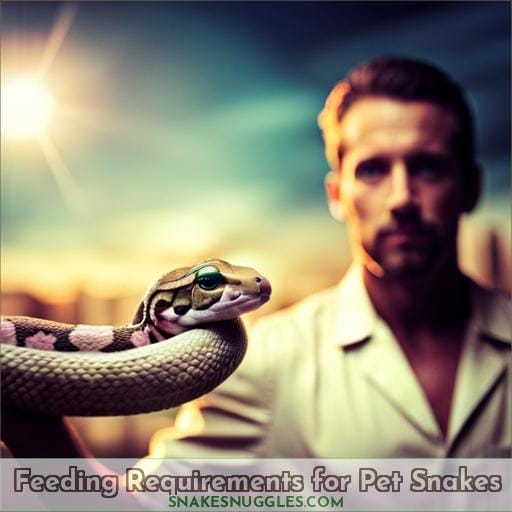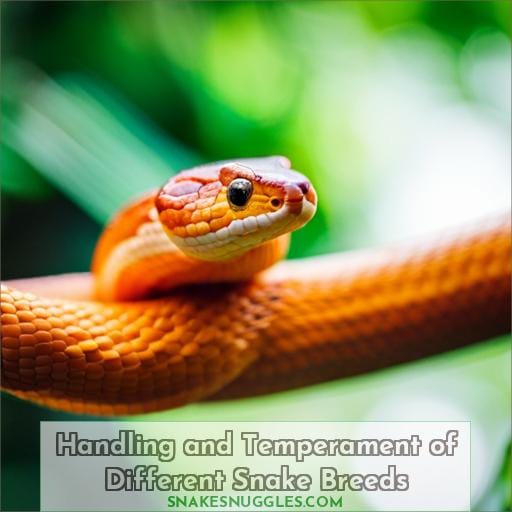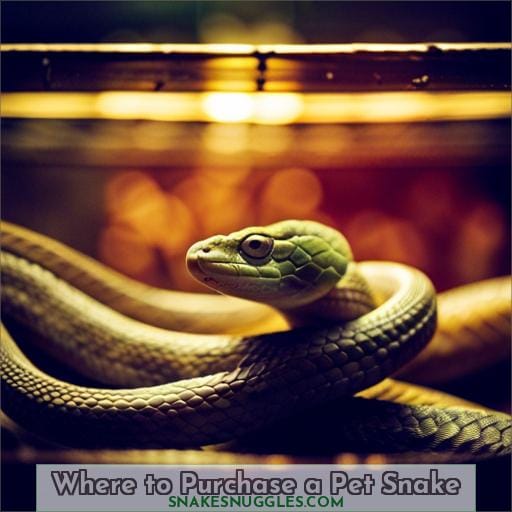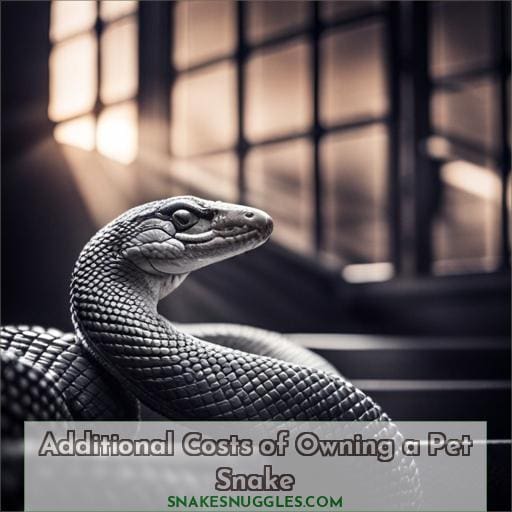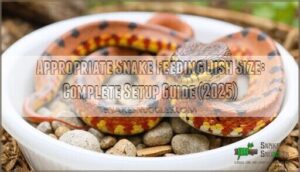This site is supported by our readers. We may earn a commission, at no cost to you, if you purchase through links.
 Finding the right snake for you is like finding a diamond in the rough – it takes time and effort, but it will be worth it in the end.
Finding the right snake for you is like finding a diamond in the rough – it takes time and effort, but it will be worth it in the end.
Table Of Contents
- Key Takeaways
- Factors to Consider When Choosing a Pet Snake
- Size of Snake
- Suitable Snake Breeds for First-time Owners
- Feeding Requirements for Pet Snakes
- Handling and Temperament of Different Snake Breeds
- Where to Purchase a Pet Snake
- Lifespan and Long-term Commitment of Pet Snakes
- Equipment and Housing Needs for Pet Snakes
- Research and Education on Snake Care
- Additional Costs of Owning a Pet Snake
- Frequently Asked Questions (FAQs)
- Conclusion
Key Takeaways
- Avoid large snakes.
- Consider the snake’s temperament.
- Purchase snakes from reputable breeders to find ethical breeders.
- Do your research on snake care.
Factors to Consider When Choosing a Pet Snake
When choosing your first pet snake, there are a few things you need to consider:
- First, consider the size of the snake.
- Second, think about what you’ll feed your snake.
- Finally, make sure you’re comfortable handling snakes.
Size of snake**
When choosing your first pet snake, it’s important to consider the size of the snake.
Avoid large snakes such as anacondas, Burmese pythons, and reticulated pythons.
Smaller snakes are more suitable for most pet owners as they need smaller cages and less food.
Food
When it comes to feeding your pet snake, it’s crucial to consider their dietary needs carefully:
- Most commonly, snakes feed on mice or rats.
- Feeding them frozen food is generally preferred over live prey.
- However, some species might demand live food occasionally due to natural instincts.
- To offer variety in their diet and meet nutritional requirements you can also supplement with small fish or worms occasionally.
Keep in mind that establishing a regular feeding schedule and monitoring their appetite are essential practices when caring for these fascinating reptiles!
**Handling
After considering the size and food of your potential pet snake, you should also think about how easy it will be to handle.
When choosing your first pet snake, it’s crucial to familiarize yourself with snake behavior signs. Snake handling safety is paramount, especially for beginners. It’s important to learn proper snake handling techniques and invest in snake handling gloves if necessary.
Some snakes are more docile and easier to handle than others, so consider your comfort level with interaction when choosing a pet snake. Remember that training and patience are key when it comes to successful snake handling.
Size of Snake
Avoiding large snakes such as anacondas, Burmese pythons, and reticulated pythons, smaller snakes are more suitable for most pet owners as they need smaller cages and less food.
When considering the size of a snake for your first pet, it’s important to choose one that fits within your space limitations and care capabilities. Popular options include corn snakes, king snakes, ball pythons, milk snakes,and boa constrictors.
These breeds typically reach lengths of 3-6 feet (0.9-1.8 meters), making them easier to handle and accommodate in terms of housing requirements.
By opting for a smaller snake breed like these examples mentioned above instead of larger species such as green anacondas or reticulated pythons,you can provide an environment that meets their needs while still allowing you the freedom to interact with them comfortably.
As always,careful research is key when selecting any reptile companion,because each breed has its own unique traits,tendencies,and specific care requirements.You should also consider factors like lifespan,long-term commitment,housing needs,equipment costs,vet visits,and overall feasibility before making a decision on which size snake best suits you.
Suitable Snake Breeds for First-time Owners
As a first-time snake owner, a corn snake or a king snake is a great option.
Here are 3 reasons why:
- They’re both easy to handle and care for.
- They’ve docile temperaments and aren’t likely to bite.
- They’re relatively inexpensive to purchase and maintain.
Feeding Requirements for Pet Snakes
Now that you’ve chosen the perfect snake breed for your first pet, it’s important to understand their feeding requirements.
Feeding a pet snake is quite different from feeding other animals, as they’ve specific dietary needs that must be met in order to thrive. Most snakes eat mice or rats, and it’s generally recommended to feed them frozen-thawed prey rather than live prey for safety reasons.
To give you an idea of what to expect when it comes to feeding your pet snake, here’s a table outlining the size and frequency of meals:
| Snake Size | Prey Size | Frequency |
|---|---|---|
| Small | Pinky | Every 5-7 days |
| Medium | Fuzzy | Every 7-10 days |
| Large | Adult Mice/Rats or small rabbits/chicks/quail eggs/worms/fish | rarely eats more than once per week |
Remember that each individual snake may have slightly different preferences and needs when it comes to food. It’s always best to consult with a reptile specialist or veterinarian who can provide personalized advice based on the specific breed and age of your new serpent friend.
Handling and Temperament of Different Snake Breeds
Consider how easy a snake is to handle when choosing a pet snake.
The handling and temperament of different snake breeds can vary greatly.
Some snakes are docile and easy-going, making them ideal for first-time owners who want an interactive pet. These snakes are inquisitive and enjoy being handled, providing opportunities for intimacy between you and your pet.
On the other hand, there are shy or defensive snake breeds that may not be as receptive to handling. It’s important to understand the specific needs of each breed before bringing one home. Additionally, consider the cost associated with proper handling equipment such as gloves or hooks if dealing with more challenging temperaments in certain species.
Where to Purchase a Pet Snake
Avoid purchasing snakes from pet stores or online retailers.
A great place to purchase a reptile is from a reputable breeder.
Attending local reptile shows can give you an opportunity to find a wide range of snakes for sale where you could actually meet the breeder in person.
Reputable Breeders
Avoid purchasing snakes from pet stores or online retailers.
A great place to purchase a reptile is from a reputable breeder.
Attending local reptile shows can give you an opportunity to find a wide range of snakes for sale where you could actually meet the breeder in person.
Local Reptile Shows
In addition to reputable breeders, you can find a wide range of snakes for sale at local reptile shows.
These shows are a great way to meet different breeders and learn about different snake breeds.
However, it’s important to do your research before buying a snake from a show, as some breeders may not be reputable.
Lifespan and Long-term Commitment of Pet Snakes
Snakes can live for over thirty years, so it’s important to consider the long-term commitment of pet snakes before bringing one home.
Here are 4 things you need to consider before getting a pet snake:
- The lifespan of your snake.
- The size of your snake.
- The temperament of your snake.
- The cost of owning a snake.
Snakes are wonderful creatures, but they can also be dangerous if not properly cared for. Do your research and make sure you’re prepared for the lifelong commitment of owning a pet snake.
Equipment and Housing Needs for Pet Snakes
Once you’ve chosen a snake, you’ll need to set up a proper enclosure for it.
The minimum tank size for a snake depends on its species, but a good rule of thumb is to provide at least 1 square foot of floor space per inch of snake.
You’ll also need to provide a heat source, a water bowl, and some hiding places.
The ideal humidity and temperature for your snake will vary depending on its species, so be sure to do your research before you set up the enclosure.
Research and Education on Snake Care
After you have chosen a snake and have the proper equipment, you’ll need to do some research and education on snake care.
- Snake handling
- Snake nutrition
- Snake housing
- Snake health
You can find a wealth of information on snake care online and from local breeders and reptile shows.
Additional Costs of Owning a Pet Snake
In addition to the initial cost of purchasing a snake, there are also additional costs to consider, such as food, housing, and veterinary care.
| Pet | First-year cost | Annual cost | Total lifetime cost |
|---|---|---|---|
| Snake | $435–$1,500 | $310–$740 | $4,775-$14,495 |
Frequently Asked Questions (FAQs)
What are the pros and cons of owning a snake?
Snakes can make great pets, but there are pros and cons to consider before bringing one home.
Snakes are low-maintenance pets, but they can live for a long time and require specialized care.
You need to make sure you have the time, money, and resources to properly care for a snake before bringing one home.
How much does it cost to own a snake?
The initial cost of a snake can range from $435 to $1,500, with annual costs of $310 to $
Snakes require specialized care and equipment, so it’s important to do your research before bringing one home.
What kind of enclosure do I need for a snake?
A snake’s enclosure should be:
- At least as long as the snake is stretched out,
- Two to three times as wide.
You’ll also need to provide:
- A heat source,
- A water bowl,
- A hiding spot.
What kind of food do snakes eat?
Snakes, fascinating creatures of power and intrigue, require a specific diet to thrive.
They predominantly eat mice or rats, preferably frozen for safety.
Some may enjoy small fish or worms as occasional treats.
How do I take care of a snake?
To take care of a snake, you’ll need to:
- Provide it with a proper enclosure, heat, food, water, and a hiding spot.
- Clean the enclosure regularly.
- Take your snake to the vet for checkups.
Conclusion
With a little research, you can find the perfect snake for you.
Doing your homework will ensure that you make a wise decision and that your new pet snake will thrive in its new home.


